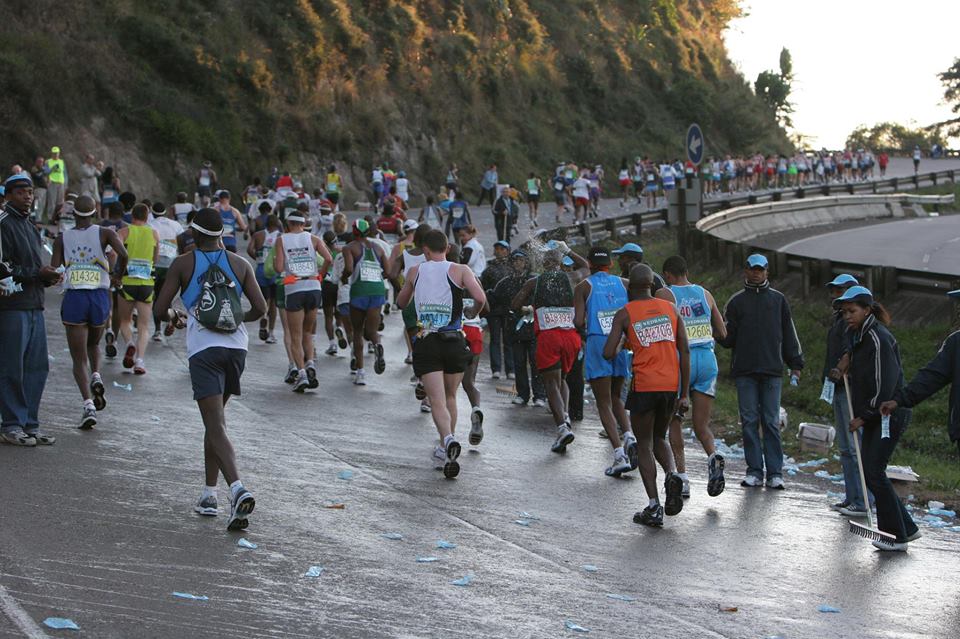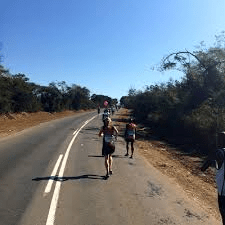– Originally published in the Nedbank Runners’ Guide to Road Race in South Africa
A detailed description for the Comrades Marathon route is not easy. Annually, there are many minor modifications as a result of road works, traffic congestion and changes in finish venue. The main features of the Comrades route are the dramatic physical variations in the Durban to Drummond stretch. On the up run, most of the climbing comes in the first half of the race.
The Comrades route has five registered hills, call them the “Big Five”. These are the stars of the show. In order of appearance they are: Cowie’s Hill, Fields Hill, Botha’s Hill, Inchanga and Polly Shortts. Three of the “Big Five” are found in the first half of the race. From the base of the first hill, Cowie’s, to the top of Botha’s Hill you climb 502 metres in the space of only 22 kilometres. Any seasoned campaigner will tell you this translates into a lot of steep climbing. The first half of the ‘up’ is challenging and early exuberance and bravado will be paid for dearly later on in the day.
The Start
The start is always a festive occasion, with blaring music in the foreground and the incessant chattering of thousands of Mynah birds in the background. The traditions of the “Chariots of Fire” theme and the recorded cockcrow of Max Trimborn add to the sense of occasion and history. It normally is moderately warm in Durban even if it is near mid-winter. Depending on the size of the field, it takes between four to seven minutes to clear the line.
“Essentially, the ‘up’ run is all about self-control – and this control has to be exercised in the first half,” writes nine-time winner, Bruce Fordyce. The little maestro is right. Just take a look at the route profile and see what dramatic physical variations occur on the stretch between the start in Durban and the halfway mark at Drummond. Fordyce continues, “Controlled running in the first half will be rewarded by an exciting second half. The first part of the ‘up’ run is littered with hills, really tough hills. From the gun we have to start climbing them: Tollgate Hill to Cowie’s Hill is a long steady climb. In the cool dawn, lulled by excitement and strength, there is a danger you may run them too hard.”
Fordyce goes on: “From the start the secret is to be cautious and maintain control. Relax as much as possible. It is important to keep on checking that pre-race schedule to make sure you have not been carried away. None of these early hills should feel difficult to climb. You should cruise them, all the time reigning in your excitement and checking that your breathing is never heavy. You should be feeling strong, enjoying the scenery – and remember to drink often.”
“You should not attempt to race anybody. If someone surges ahead of you, let them go. You should also ignore the distance boards. The countdown of 80 kilometres to go, 75 kilometres to go, and so on is frightening. Rather, you should run to landmarks. The idea is to aim for the next major hill, rather than the next five kilometres – and aim to get there feeling strong.”
“As you enter Pinetown and find the dense crowds, you will feed off their support, but once again try to avoid being caught up in the excitement. Around Pinetown you will want to start drinking your special race formula drink in anticipation of the major efforts ahead.”
Fields and Botha’s Hill

“Two major obstacles lie ahead: Fields Hill and Botha’s Hill. Both hills should feel like long, steady pulls, but should not be crippling. I always know whether I am going to have a good Comrades or not, as I climb Fields Hill. If Fields Hill feels easy and I am able to talk to the other runners, I know that I will conquer the ‘up’ run that day. If you have to walk on any of the major hills, walk. It is important to conserve your strength. Once you have climbed Fields Hill, a major obstacle is behind you.”
At Botha’s Hill Village there are still about six to seven kilometres to run before the halfway point. There is a danger of rushing to the halfway point and being confused by the tree-lined bends and drops that lead to Drummond. At Drummond you run through a mass of spectators. Beware; the official halfway point is under the halfway banner, and nowhere else.”
Inchanga
The Inchanga bank is a long, punishing pull that saps the strength. Take this cautiously; if you can reach the summit feeling strong, a great race is on the cards. But even at the top you still need to be cautious, the Inchanga climbing only ends at Radnor.
Once over the mighty hill, Inchanga, the bulk of the climbing is behind you. The Comrades Marathon has a number of rare treats in store and one of them occurs at this point. Here you will encounter a tunnel of wildly cheering school children from the Ethembeni Home. This is a special place for reflection, for these children are either on crutches or in wheelchairs. The noise is enormous and the excitement tangible as you pass through this celebration. Many runners find great mental and spiritual upliftment here. Hardly a dry eye leaves this little corner.
Now you start the slightly downhill run on the flat stretch to Cato Ridge and Camperdown. If you are feeling good you can make up time here. From Cato Ridge to Camperdown the running always gets tough. This is a deceptively uphill stretch and it is hard work in contrast to the easy coasting run down to Cato Ridge.
Bruce Fordyce picks up the journey from Camperdown: “Things start to really get tough as you fight fatigue and cramps. There is enormous crowd support in Camperdown, but there are three unnamed hills immediately after the village. I know them as Camperdown one, two and three. Camperdown three is the tough one. It is a steep, fairly long climb and it hurts. The good news is that it is followed by a welcome descent. Mentally, it is wonderful to be running well here because this is a very lonely part of the Comrades route. The scenery consists of hot, naked veld.”
Umlaas Road
“Umlaas Road is the highest point and here the race is either won or lost. If you are feeling strong, you can make up time on the drop to Tumble Inn. From Umlaas Road you can also see the dreaded Polly Shortts in the distance. If you have timed yourself well and run your race cautiously, this can be an inspiring sight. You are now finally able to see the hill that guards Pietermaritzburg and the finish.”
“From Umlaas Road you plunge steeply into Ashburton. Your legs will be sore, but you can make up time. For me, the toughest part of the race is Ashburton, or Little Polly’s as it is nicknamed. It is a deceptive and hard climb and it warns the tired runner just how tough Polly Shortts is going to be. For novices Little Polly’s is a trap. Too many believe it to be Polly’s itself and are left demoralised and beaten a little later when they meet the real Polly’s.”
Polly Shortts
“There is no mistaking the real Polly Shortts: after a drop from Ashburton, a slight bend in the road and a short bridge, the real hill begins. Polly Shortts is almost two kilometres long and bends deceptively three times. Each time you will be fooled into believing you are near the top. No one runs quickly up either Ashburton or Polly Shortts. Even front runners are occasionally compelled to walk. Speed up Polly’s is not important. The main thing is to keep progressing forward.”

“Don’t believe the lie that the race is all downhill from the top of Polly Shortts. There is still some running left to the finish. Pietermaritzburg has its fair share of undulations and with the change in finish venue, the last seven or so kilometres will prove a stern test for any, even the most experienced campaigners. But if your early race has gone well, the last stretch can be run confidently and well, and from now you can enjoy the massive crowd support. I have no doubt that the second half is far easier than the first half and it can be run strongly if the first half has been run judiciously.”
The following table defines the “Big Five” hills in terms of difficulty taking into account the length and steepness of the hill and the distance from the start.
| Hill | Cowie’s | Field’s | Botha’s | Inchanga | Polly Shortts |
| Length (km) | 2.1 | 3.2 | 2.3 | 2.5 | 1.8 |
| Height (m) | 101.7 | 186.0 | 116.6 | 139.4 | 119.6 |
| Distance from start | 15 | 22 | 35 | 45 | 79 |
| Steep ratio | 48.4 | 58.1 | 50.8 | 55.7 | 66.4 |
| Difficulty | 3.2 | 13.1 | 9.4 | 15.7 | 17.0 |

To summarise: The Comrades is characterised by five major hills, the “Big Five”. Each presents a unique challenge. The first half of the route has the most dramatic variation in profile where you climb three of the Big Five before the halfway mark. By contrast the second half is flatter and easier. The halfway point and the end lie roughly at the same height above sea level, with the highest point – Umlaas Road – a mere 170 metres above Pietermaritzburg. The real challenge of the up run is to manage the difficulty ratio of the hills. This takes into account the length and steepness of each hill together with the distance from the start.


You must be logged in to post a comment.